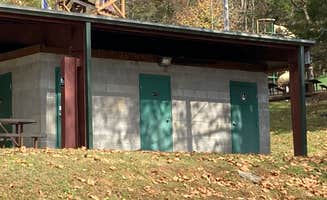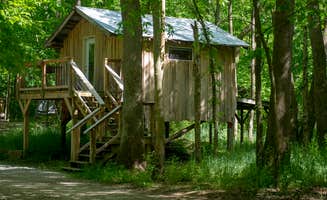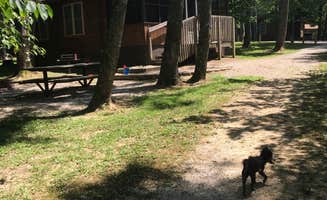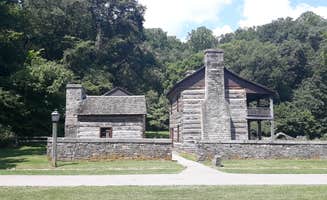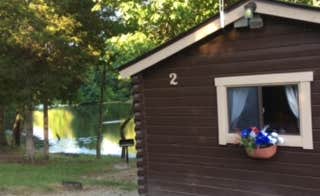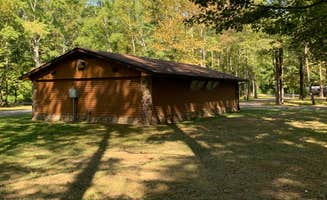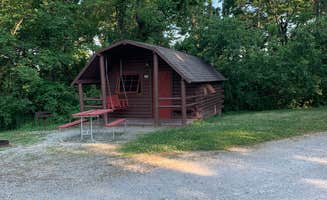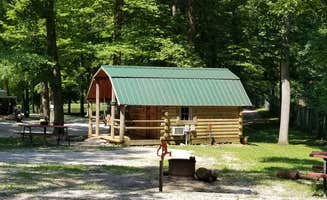Camping cabins near Sulphur, Indiana offer access to a terrain characterized by limestone karst topography with numerous sinkholes, caves, and springs within the southern Indiana hills. Elevations in this region typically range from 500-700 feet above sea level, with temperature fluctuations between seasons creating distinct camping experiences. Weather patterns in this area include humidity during summer months with temperatures frequently exceeding 85°F, while fall brings cooler temperatures and colorful foliage changes.
What to do
Cave exploration: 1-2 hours per tour. Visitors staying at Marengo Cave Campgrounds can explore the national landmark cave system with both dripslide and crystal palace cavern tours. "I was really surprised that in my 30 years of living in Indiana, I had never been to Marengo Cave. It's both great for kids and adults. The people are super friendly and there are two different parts to explore," notes one visitor. The caves remain at a constant 52°F year-round, requiring light jackets even during summer.
Hiking woodland trails: 1-3 miles typical length. The forests surrounding Hoosier National Forest South Slope Loop Campground provide several trail options. A camper reported, "We spent our time hiking on the Interpretive Trail (1mi) near Celina Lake and Two Rivers Trail (15 mi) which encompasses both Celina and Indian Lake." Trails range from flat, accessible routes to more challenging terrain with significant elevation changes.
Lake activities: Daily from sunrise to sunset. Fishing and non-motorized boating are popular at several area lakes. "We spent time at the lake also. Very peaceful, electric motors only so no waves or tubers flying by. There is a small handicap accessible fishing pier adjacent the parking area," mentions one visitor to Hoosier National Forest. Most lakes in the region restrict watercraft to electric motors or paddling only.
What campers like
Free firewood service: Sycamore Springs Park provides complimentary firewood for campers. "We were able to go 'creeking' do trail walking, bike riding. Just a super neat little place. They even have a little village set up houses to play in! There is even free firewood!" explains one satisfied camper. The firewood is typically stacked near each campsite and regularly replenished.
Multiple playgrounds for children: Family-oriented cabins and campgrounds feature extensive play areas. A visitor to Sycamore Springs Park mentioned, "So much to do with the kids, from swimming in the creek, fishing, campfires, s'mores, fresh black topped roads, and such friendly staff. Clean bathrooms and showers, and beautiful places to visit also. Tons of playgrounds too spread throughout the campground." These play areas typically include modern equipment on mulched safety surfaces.
Clean bathhouse facilities: Buffalo Trace Park maintains well-kept shower facilities with regular cleaning schedules. "The bathrooms are dated but very clean," noted a recent visitor. Modern bathhouses at most cabin campgrounds include individual shower stalls, flush toilets, and sinks with hot and cold running water. Some facilities are heated during cooler months for year-round comfort.
What you should know
Alcohol policies vary by location: Some campgrounds enforce strict no-alcohol rules while others permit responsible consumption. A camper at Happy Hollow Homestead explained, "The drive to this property is very easy and we had no trouble finding it. However, there is not a sign for the campground, so just follow your gps." Review each campground's regulations before arrival as fines may apply for violations.
Limited cell service at some locations: Communication can be spotty in more remote cabin areas. "No WiFi but they said they are having it installed. T-Mobile had good service," reported a Buffalo Trace Park visitor. Cell reception varies widely, with valleys and forested areas experiencing the most significant signal limitations. Some campgrounds offer WiFi near registration buildings or camp stores.
Seasonal operation schedule: Many rental cabins close during winter months. "Most sites are available from April 15 to October 15," notes information from Hoosier National Forest South Slope Loop Campground. Early spring and late fall visits may encounter limited amenities or seasonal maintenance work. Some cabins that remain open year-round may have reduced services during off-season periods.
Tips for camping with families
Children's activities beyond playgrounds: Lake Lincoln Campground offers organized nature programs and seasonal events. "My kids love Lincoln especially around Halloween when they do their trick or treating. Great bathrooms, great sites, lots of walking trails, close to Holiday World, so much to do with kids," shares one parent. Check campground bulletin boards for scheduled ranger talks, crafts, and guided hikes specifically for children.
Accessible outdoor recreation options: Several areas provide accommodations for children with mobility challenges. "There is a small handicap accessible fishing pier adjacent the parking area," notes a visitor to Hoosier National Forest. Paved paths between cabin sites and facilities typically measure 3-4 feet wide and maintain gentle grades for easier navigation with strollers or wheelchairs.
Rustic camping alternatives: Cabin options range from basic shelters to fully-equipped units. "We stayed in a tent camp site. Having electric and water was nice. The bathrooms near 119K were personal bathrooms with a shower, toilet, and sink. So much better than a community bathroom," explained one visitor about their experience at a nearby campground. Consider individual family needs when selecting between primitive and modern cabin accommodations.
Tips from RVers
Site leveling considerations: Terrain at many campgrounds requires adjustment equipment. "Make sure you have plenty of leveling blocks. We used all of ours and was not level," advised a camper at Buffalo Trace Park. Cabin renters should note that cabin foundations are generally level, but outdoor gathering areas may have slopes. RVs and trailers often require blocks or levelers due to the natural terrain.
Campground layout navigation: Charlestown State Park Campground features well-organized loops and sites. "Campground was nice with concrete pads and full hookups. Campground was not heavily shaded, but we didn't mind that at all. We biked throughout the park and hiked 4 of the trails," reports a visitor. Most cabin areas include site maps at check-in with numbered locations and facility indicators to help with orientation.
Water access points: Not all sites provide direct water connections. "The sites we where at was heavily sloped, the only flat part was where they put the fire pit at," noted a camper at Spring Mill State Park. While most cabin sites include electricity, water access may require filling containers at centralized spigots located throughout the camping areas. Check availability of water connections when booking.


